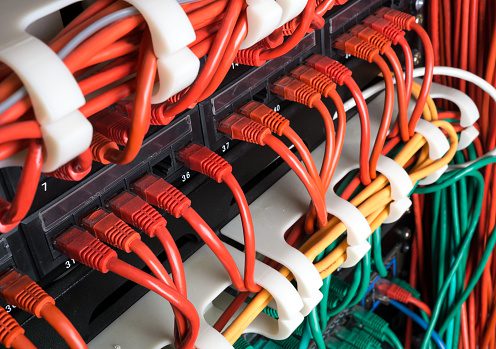With mobile devices and cloud access, today’s organizations provide more flexibility for their workers. However, your growing business still requires on-site hardware to store information on servers, or use powerful workstations with wired Internet connections for design or engineering.

When hardware needs expand, it can cause “Cable Confusion.” Wired connections are often difficult to maintain, and without proper organization they can turn into a confusing mess. This isn’t just annoying – it’s a serious problem that causes major setbacks if cables are damaged or disconnected. And, in the worst-case scenario, improperly installed cabling creates a fire hazard.
Structured Cabling is the Answer.
Structured cabling is the design and installation of cabling systems to support multiple hardware devices. Small companies with limited hardware typically don’t need structured cabling. However, as they grow, and require data banks and additional workstations, cable management is essential
Standards for Structured Cabling
The Standards for Structured Cabling are governed by three different organizations:
They oversee a set of standards for data and voice communications using various kinds of cable. These standards provide best practices that data specialists must use when setting up complex wired networks. With a properly installed system your requirements for both today and tomorrow will be met, so when you add hardware it will be supported.
The Benefits of Structured Cabling
You may be thinking, “This is all about keeping cables organized? We can do this on our own.” The truth is that most don’t know how to organize cables and wired connections, and because of this, they set themselves up for chaos. It’s best to let the experts install your structured cabling. Here’s why:
Standard Specifics: The Four Key Sections
Structured cabling is divided into four different sections. Each section acts like a checklist when installing and organizing cables. They’re meant to work together during the setup process.
Digging into these standards reveals a long list of obscure technology and installation terms that many small and mid-sized businesses are unfamiliar with. However, the goal is clear: Make sure cables are reliably set up in a safe, practical way.
Using Cable Standards in Your Business
Clearly, there are many situations where these standards can be used, and they may require different strategies depending on the situation. For example, a retrofit may need a very different approach to meet structured cable requirements than installing brand new software. Working on an older building that has been converted to an office may require innovative solutions, compared to a modern office building built with these codes in mind.
That’s not even touching on manufacturer warranties and how they relate to installation, or how scaling up in the future may change cable needs. The bottom line is that structured cabling can be more complex than it first appears. This is why it’s important to find vendors, service providers, and installation experts who understand structured cabling and utilize best practices.
If you need such an expert for your business in , we can help. specializes in providing the IT and structured cabling services support growing companies require. Contact us at or for a complimentary assessment of your needs.